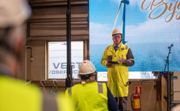Norway’s Prime Minister Erna Solberg and Kværner apprentice Arne Linga were on hand at the launch of construction of Hywind Tampen, a floating offshore wind farm, at Kværner Stord. The technology project opens up new opportunities for Norwegian industry.
Prime Minister Solberg and Linga started the cutting robot on the project’s first sheet of steel on Thursday, 1 October. Kværner’s assignment will include building 11 floating concrete hulls for the turbines on Hywind Tampen.
"Hywind Tampen is a new chapter in Norway’s narrative as an energy nation. With support from the Norwegian authorities, we’re not only building Norway’s first offshore wind project; we’re refining floating offshore wind technology along with the Norwegian supplier industry," says Equinor president and CEO Eldar Sætre.
"Eighty percent of the world’s offshore wind resources are located in deep water areas and are available for floating offshore wind projects. If we can use projects like Hywind Tampen to make floating offshore wind competitive with other forms of energy, the technology will be able to deliver large-scale renewable power and contribute to a more sustainable global energy supply. A floating offshore wind market will also open up considerable industrial opportunities for Norwegian industry," Sætre says.
The development of the Hywind Tampen project involves around 250 full-time equivalents for Kværner employees. Kværner’s project will also generate around 800 full-time equivalents in ripple effects for suppliers and the public sector, among others.
A study conducted by Multiconsult shows that, in total, the Hywind Tampen project could provide 1,550 to 3,000 full-time equivalents in ripple effects for the Norwegian private sector.
Equinor’s ambition is for floating offshore wind to be competitive with other forms of energy by 2030. "By using larger turbines, concrete substructures, new technology and a new assembly method, we’re well on our way toward delivering on the objective to reduce costs by more than 40% compared with Hywind Scotland. This is an important step to establish floating wind as a sustainable power supply alternative," says Hywind Tampen project director Olav-Bernt Haga.
"If more major floating offshore wind projects are realised in the future, it will be possible to reduce costs even further, and we could see a development in cost reductions equivalent to the one we’ve seen in fixed foundation offshore wind," Haga says.
Equinor sees a potential for floating offshore wind projects in Norway, the UK, Europe, the US and Asia. The Hywind Tampen project will be the first floating offshore wind project to supply renewable power for oil and gas installations. The wind farm will have a total capacity of 88 MW, and is expected to cover about 35 percent of the annual power needs on the five platforms Snorre A and B and Gullfaks A, B and C.
Hywind Tampen will reduce emissions from the Gullfaks and Snorre fields by more than 200,000 tonnes per year, which corresponds to annual emissions from 100,000 private vehicles.
Equinor has been a pioneer in floating offshore wind technology and has been working on this technology for nearly 20 years. When the Hywind Tampen project is operational in 2022, the company will be operating one-third of the global floating offshore wind capacity.

